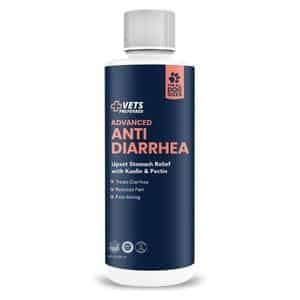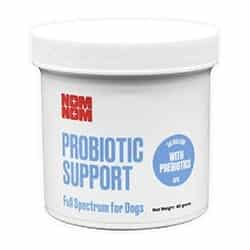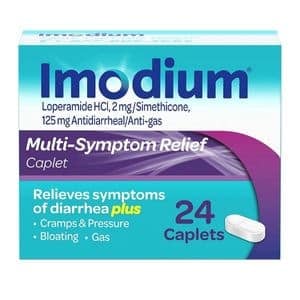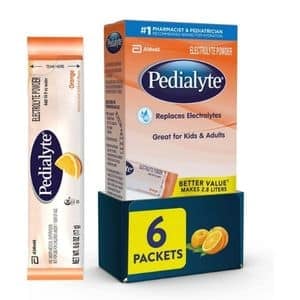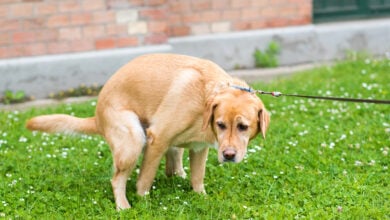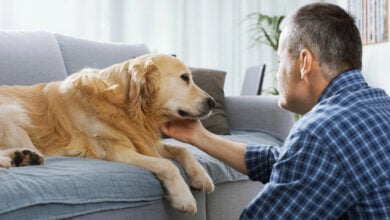Dog Diarrhea: What To Give, Treatment, Causes, Home Remedies & More
When you purchase through links on our site, we may earn a commission. Here’s how it works.
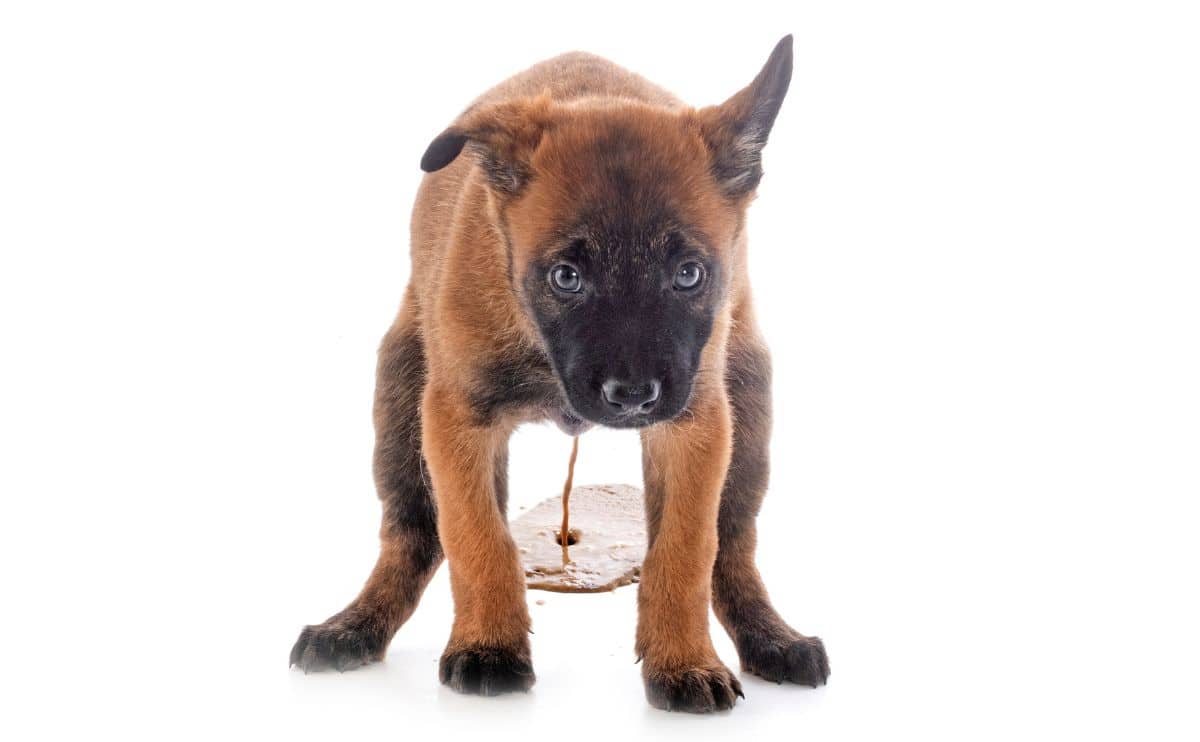
Any person who has experienced the runs knows the runs are no fun for anyone. When it comes to dogs, diarrhea can be a messy situation for you and your dog. There are a number of different causes. From a minor upset stomach and eating something they shouldn’t have to something more serious like parvo that could be a cause for concern. We’ll go over the various types of doggy diarrhea and various treatment options (depending on diagnosis). It’s important to identify the root problem before properly treating your dog’s poo problems.
Table of Contents
How To Diagnose
Diarrhea is defined as loose or unformed stool that occurs in larger-than-usual amounts, more often than usual, or both. If your dog has diarrhea, you’ll notice some obvious changes in his bathroom habits. For example, he will want to go outside more. He may also have more frequent bathroom “accidents”, than he normally does.
If you think your pup has diarrhea, you may need to check his or her feces to inspect the consistency. It can often be hard to tell if puppies have diarrhea because they generally have a soft stool to begin with. However, if the diarrhea is almost liquid, this is a sign that something is wrong.
Even if you’re fairly sure that your dog has diarrhea, you’ll want to talk to your vet. A quick phone call to your vet may be all that’s needed to get started on treating the diarrhea, especially if the diarrhea is mild and your dog otherwise seems fine.
You could also take your dog to your vet for an official diagnosis (especially if doesn’t resolve on its own or is an ongoing issue). Your vet will perform a physical exam, a fecal exam, and possibly other diagnostic tests to figure out what’s causing the diarrhea and how to treat it.
Causes
Dog diarrhea has a long list of causes, ranging from a mild case of digestive upset to serious health conditions like inflammatory bowel syndrome or liver disease. With puppies, it can be difficult to assess the true cause of diarrhea because they are very much like human babies: their system is young enough to have difficulty processing new foods, so any change in diet can cause diarrhea.
Types Of Dog Diarrhea
Dog diarrhea is categorized into types according to duration (acute vs chronic) and location (small bowel vs large bowel).
Duration
The duration of the illness may help you, and your vet better understand whether this is a short-term concern or a longer-term health concern to be watched and treated.
- Acute Diarrhea: Lasts for fewer than 14 days
- Chronic Diarrhea: Lasts for 14 or more days
Location
While one is not likely to be a more significant concern than the other, identifying where the problem originates is essential for determining the diagnosis and treatment plan.
- Small Bowel Diarrhea – abundant in quantity and can have dark red blood (melena). It typically has a loose and watery “cow-pie” appearance. Dogs with small bowel diarrhea will have a normal or increased frequency of defecation.
- Large Bowel Diarrhea – small in quantity and can have flecks of fresh, bright red blood (hematochezia). It is loose to semi-formed. Dogs with large bowel diarrhea poop far more frequently than dogs with small bowel diarrhea.
Appearance Of Dog Diarrhea

There are several types of diarrhea. It’s important to know the normal state of your dog’s stool so that you can accurately determine if it’s any different than normal. Normal dog stool is solid, formed, and chocolate brown. Contact your vet if you notice any of the changes that are described below in your dog’s poop.
- Soft Stool With No Blood Or Mucous – If your dog has soft feces, it may be something as simple as having eaten a new food or an object that wasn’t meant for consumption. However, it may also be a sign of parasites or stress. Monitor your dog closely and seek medical attention if the condition persists or worsens.
- Greasy Gray Stool – When dogs have this type of diarrhea, it is usually a sign that they have eaten greasy food or too much fat. Reduce the fat content of the food your pup consumes to see if this solves the problem.
- Black Stool With A Tar Type Texture – When your pup has a black, tarry look to his feces, it’s a sign that there is old blood in his digestive system, typically in the upper digestive tract (stomach, small intestine). This may be a sign that the pup ate something that caused internal damage or that he or she has a serious disease such as cancer, or a tumor. Seek medical attention immediately.
- Liquid – Dogs that have liquid diarrhea may have a viral or intestinal infection. Since dogs are at high risk for dehydration in these situations, be sure to monitor the pup closely and use preventative methods of treatment. If the condition persists, seek medical attention.
- Mucous – Dogs who develop a stool with a mucous-type membrane or stringy substance may be at serious risk for diseases such as Parvo. It may also be an indication of the presence of parasites. Seek medical attention immediately.
- Worms Or Other Living Things – If you notice that there are worms or other living things present in your dog’s stool, promptly take him or her to the vet so they can be treated accordingly.
- Solid Stool With Fresh Blood – When your pup has any type of blood in their stool, he or she is experiencing a serious health problem. If the blood is fresh, it is a sign that there is currently bleeding inside of your pup. It may be in the large intestine or the anal glands. Your pup may have eaten something that perforated his or her intestinal wall, or this may be a sign of the eruption of a tumor or an ulcer. Seek emergency medical attention immediately.
- Soft Or Runny Stool With Blood Or Blood Clots – Bloody diarrhea can be an indication of a serious health problem. That problem can range from something the dog has eaten to more serious conditions like parasites or parvovirus (Parvo). The fact that your pup not only has diarrhea but also has blood in the diarrhea should be taken seriously. The condition may pass within a day or two if the pup has eaten something unhealthy. However, if the pup, especially a young, unvaccinated puppy, has a disease such as Parvo, they can quickly dehydrate and die within a day or two. Seek medical attention immediately.
Learn More About What Your Dog’s Poop Color Means
Treatments
After your vet has diagnosed your dog’s diarrhea and determined what’s causing it, they will devise a treatment plan to treat (or manage) the underlying cause and get your dog’s poop back to normal. Your primary goals in treating your dog’s diarrhea should be to get your dog’s poop back to normal consistency and get the frequency of your dog’s bathroom habits back to normal.
Do not attempt to treat your dog’s diarrhea before talking with your vet and knowing what’s causing the diarrhea. Although simple at-home treatments may be all that’s needed in mild cases of diarrhea, it’s best to wait until after you’ve talked to your vet to start any type of treatment.
If your pup has more than just a mild case of diarrhea, it is likely that they will need additional treatments to treat the diarrhea. For example, if your dog has a bacterial infection in the digestive tract that’s causing the diarrhea, antibiotics would be needed. For intestinal parasites, your pup would be given a dewormer to kill the parasites.
If your pup is severely dehydrated or otherwise ill from the diarrhea, they will need to be hospitalized to receive more intense treatment, such as intravenous fluids. Your vet will let you know the level of treatment that your pup will need.
And remember, vets are not cheap so consider getting pet insurance to help offset some of the bills. We have a guide to help you decide whether pet insurance is worth it, and our experts have chosen the top providers for this year.
Home Remedies
If your vet has advised you that you can treat your dog at home or suspect the cause is due to something they ate, these are some options to help alleviate their symptoms. Be prepared to be diligent and ready to seek medical attention if your dog’s diarrhea does not improve after a day or two.
Easily Digestible, Bland Food
If your dog is able to eat, give him chicken broth. When he is able to eat the broth, add unseasoned boiled chicken and/or rice to the broth. This type of food is easy for the dog to digest and does not have the fat that is often found in beef products. You want to avoid fatty foods that may make the diarrhea worse.
Maintaining a bland diet while on medication is key to preventing an upset tummy. Most veterinarians will suggest feeding a diet of unseasoned boiled chicken and white rice in order to keep your dog’s diet as bland as possible. The ratio of chicken to rice in this combination should be 1:3.
Continue upon this course of action until the dog is behaving normally and has solid stool.
Pumpkin
In mild cases, a dietary supplement or canned pumpkin can help ease their digestion and get things back on track. The high-fiber food is packed with vitamins, iron, and potassium which contain important minerals that aid in a number of ways. Like with the bland diet, start slow and give only a half or one tablespoon as not to upset their stomach further.
Make sure you use a pumpkin with no additives or seasonings, which will do more harm than good. Canned pumpkin is readily available at the supermarket and is better than fresh pumpkin that contains more water.
Anti Diarrhea Product
If you’ve tried natural solutions and are not having any luck, you might speak to your vet about using an over-the-counter option. Vets Preferred Anti Diarrhea is an option that helps restores gut health from diarrhea caused by imbalanced nutrition. It also helps with gas relief and is fast-acting within a day or two, symptoms should subside for mild cases of diarrhea.
Dog Probiotics
Many dog owners that have dogs that are prone to antibiotic-induced diarrhea find that probiotics are very helpful. Probiotics can be added to food or ingested in pill form. Probiotics introduce billions of beneficial microbes into your dog’s gut, thereby boosting the production of digestive enzymes and improving overall immune function. One of the most popular canine probiotics currently is made by Purina. Read our reviews of probiotics for dogs.
Medication
Always check with your veterinarian before implementing a course of anti-diarrheal medication for your dog (especially if they are already taking another medication). If your vet approves this treatment, then make sure that you have the appropriate medication on hand when your dog is prescribed antibiotics.
Imodium (loperamide) is commonly used to treat diarrhea in dogs and cats, but if symptoms do not clear up quickly with use, contact your vet to discuss other options.
Water
Dehydration is a major side effect of diarrhea. To keep your dog hydrated, you need to make sure he has plenty of fluids and electrolytes. Unlimited access to fresh water is the first choice of liquids. A dog water fountain can help entice them to drink.
Electrolytes
Anytime your dog suffers from multiple incidences or prolonged incidences of diarrhea, they run the risk of electrolyte imbalance. Unflavored Pedialyte and other electrolyte-filled liquids are additional options to help your pup stay hydrated and keep their electrolyte levels healthy.
This can be difficult if your pup is not interested in eating or drinking. If this is the case, use a syringe to give your pup the liquid. Place the syringe at the back of your dog’s mouth, near the top of the throat. If he has trouble swallowing, massage the throat. This will cause a natural reaction of swallowing. (You can also put the syringe in the back of the pup’s cheek.) If the dog has no problems swallowing, this method may be more comfortable for him.
If your dog still refuses to drink or take it, talk to your veterinarian about other methods for maintaining healthy electrolyte levels in your dog with antibiotic-induced diarrhea. Ask your vet about how much Pedialyte to give your dog.
How To Check For Dehydration In Dogs With Diarrhea
One of the biggest health risks associated with diarrhea in pups is dehydration. However, there are other risks to be concerned about. Continuous diarrhea can cause problems with the digestive tract in general and lead to serious nutrient and electrolyte deficiencies. Something else to consider is the spread of disease. Your pup may pass their illness along to other pets in your household.
Since dehydration is one of the worst potential results of diarrhea, every dog owner should learn how to check for dehydration.
Check Gums
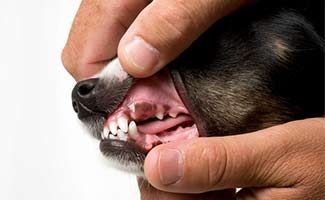
They should be pink and shiny with wetness. If you push on the gums, the area that you push on should automatically fill back up with blood within two seconds.
If your dog’s gums feel sticky or do not quickly fill back up with blood after touching them, your dog could be dehydrated. Check your dog’s gums before he gets sick so that you have something to compare the results to if he does get sick.
Check Skin Elasticity
Much like humans, the liquids in your pup’s body help his or her skin to maintain elasticity. If you pinch the skin on your hand, it should go back to its original shape as soon as you let go of the skin. The same is true of your pup but can be hard to see because of the fur. Grasp the skin on your dog’s neck. When you let go of the skin, it should immediately fall back in its place on the dog’s neck.
If the skin maintains a tent-like shape after you let go of it, your pup is dehydrated and needs immediate veterinary care. If you are unable to get to the vet immediately, you can use the treatment method listed above to help with the dehydration until you can get to the vet. However, you should get to the vet as soon as possible for intravenous fluid therapy.
Antibiotic-Induced Diarrhea
When referring to diarrhea in dogs, it is important to distinguish between diarrhea induced by antibiotics and diarrhea caused by illness. Diarrhea that is caused by antibiotics can occur shortly after antibiotic treatment begins.
When dogs (just like people) take antibiotics, they can experience side effects, including diarrhea. This type of diarrhea occurs because, while antibiotics are designed to kill off bacteria causing the infection (or prevent infection in the case of post-surgery antibiotics,) they can also kill off the beneficial bacteria in your dog’s digestive tract. As the beneficial bacteria numbers in your dog’s intestines decline, the balance of bacteria in the intestines is thrown off, and diarrhea results.
Factors That Affect Dogs Experiencing Diarrhea From Antibiotics
Not all dogs will experience antibiotic-induced diarrhea, and there are a number of factors that will determine whether your dog does.
- Overall Health – One of the biggest factors influencing whether or not your dog will experience antibiotic-induced diarrhea is their overall health. Some dogs – just like some people – tend to have weaker immune systems and “weaker stomachs.” These dogs are more likely to experience diarrhea as a result of antibiotic use.
- Type And Strength Of Antibiotic Used – Another major player is the type, dosage, and potency (strength) of antibiotic used. Certain types of antibiotics are simply stronger in terms of being able to kill off bacteria in a shorter time period, and these antibiotics can quite quickly result in an upset stomach. Additionally, the dosage of antibiotics can play a role in antibiotic-induced diarrhea as well. A higher, more aggressive dosage could quickly kill the bacteria but also increase the risk of diarrhea.
- Length Of Treatment – The longer a dog is exposed to antibiotics, the higher the risk that beneficial bacteria in their digestive tract will be killed, resulting in diarrhea.
Should I Stop My Dog’s Antibiotic Course If It’s Causing Diarrhea?
Pet owners are always advised to give their pups their recommended course of antibiotics in order for the treatment to be fully effective in killing infection-causing bacteria. There is a question, however, as to whether antibiotic therapy should be continued even if it is resulting in severe diarrhea. The problem, in this case, is that stopping antibiotics runs the risk of recurring infection. However, continuing the antibiotic may result in severe dehydration and malnutrition.
If your dog is experiencing severe diarrhea as a result of antibiotics, it is always best to consult your veterinarian before stopping your dog’s medication. Your vet may recommend an anti-diarrheal to be taken in conjunction with the current antibiotic so that the current treatment course may continue. Your vet may also recommend switching to another type of antibiotic that has a lesser occurrence of diarrhea.
There are a number of antibiotics that are known for being gentler on the stomach and a handful that are known for being particularly harsh. If your dog has had trouble with antibiotic-induced diarrhea before, this is worth mentioning to your veterinarian. This type of information can help your vet to select a medication that will be gentle on your dog’s stomach.
Unfortunately, in some circumstances, there is no other option than treatment with the current diarrhea-causing antibiotic. This type of situation does not occur too often, but when it does, it occurs as the result of targeted medications that lack alternative treatment methods.
When this occurs, your veterinarian will assess your dog’s overall situation and suggest a course of treatment that is right for your dog. This course may consist of continuing the antibiotic or stopping the antibiotic and trying another treatment approach.
What Can I Do To Prepare My Dog For Antibiotics?
In many instances, when pet owners know that their dog is prone to antibiotic-induced diarrhea, they can begin preparing their dog for diarrhea treatment options above as soon as they receive the diagnosis.
How To Prevent Dog Diarrhea
There are several easy things you can do to prevent diarrhea. Most of these involve controlling their diet to ensure their stomach stays at ease.
- Avoid Giving Table Scraps – Not only can table scraps cause bad habits such as begging during dinner, but the constant change in food will make it difficult to assess if the pup is having any health problems.
- Maintain A Consistent Diet – Keep your dog on a consistent diet (at least until they are old enough to begin eating adult food). By then, you’ll have seen enough of your pup’s stool samples to be able to establish a baseline of what their stool looks like. If you constantly change his diet, there will be no baseline, and you will have problems trying to establish whether your pup is actually sick or if the change in stool is due to a change in diet.
- Keep A Watchful Eye On Your Dog – Watch your pup closely, especially until they outgrow the chewing stage. Before this stage is over, they will swallow more unhealthy items than you ever thought of, and keeping a close watch can save you a lot of worry in the long run.
Other Tips To Keep Your Dog Healthy
keep your dog up to date on all of their vaccinations. Be sure to take your dog to the vet for an annual wellness visit to detect and treat health issues as soon as possible. Choose nutritious dog food and stick with it. Change brands gradually if your pet develops food allergies but try to stick with a healthy dog food — visit our review of various high-quality dog food delivery options — and do not feed your dog table scraps.
